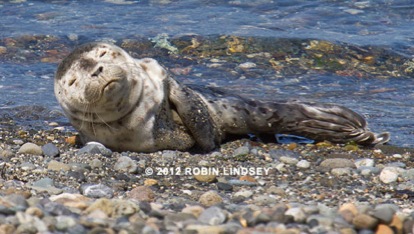Strange and unsettling seal pup season
Oct/29/12 06:06 AM

We want to assure people that this does not mean we have a seal pup “death epidemic”. Harbor seal pups only have a 50% chance of surviving their first year. This is due to many factors, including predation and disease. This means, in theory, one out of every two pups that our volunteers watch over can perish. And we do respond each year to numerous dead animals. However, in West Seattle our response mortality rate has just never come close to approaching such a high percentage at this point in the season as our current 44% rate for 2012. But what has been equally unsettling is that so many of our live pups this year have been terribly thin. As we still have two full months remaining in 2012, our total pup deaths will undoubtedly exceed last year’s count, but the mortality percentage will change - hopefully, for the better and not worse. Winter months pose grave difficulties for weaned seal pups. At the end of the year, we will post our final statistical findings.
Harbor seals are considered by biologists to be an indicator species for the health of our waters. Year-round residents, they do not migrate. Harbor seal pups are especially vulnerable to any kind of imbalance in our waters, including contaminants and disease, due to an already weakened immune system. While nursing, a pup has the benefit of partial immunity from mom’s milk. However, once the pup is weaned, there is little protection from emerging diseases. Contaminants, such as flame retardants and storm runoff, pose tremendous risk to seal pups (as well as all living marine organisms - read more on our website) and contribute to virus infection. Additionally, a pup usually drops a fair amount of body weight after being weaned and trying to forage on his own. Opportunistic parasites, such as lungworm, take advantage of this further suppressed immune system, often leading to respiratory disease and pneumonia, a very difficult health challenge for a pup to overcome.
We want to stress that at this juncture we have no idea if there is an underlying link causing these thin pups and deaths, but have been consulting with a prominent marine mammal biologist and inquiring as to statistics from other stranding networks. Perhaps we simply have fewer healthy pups hanging out in West Seattle because there is not a sufficient food source in our area this year. Perhaps if food sources were depleted, moms didn’t nurse the full 4-6 weeks, leading to weaker pups. Or, could there be something else going on?
Research is critical to monitoring the health of harbor seal populations and that of the Sound. Unfortunately, there is inadequate funding for crucial, and relatively expensive, tests. Federal Prescott Funds which support the vital work of NOAA’s nationwide marine mammal stranding networks is on the chopping block to be eliminated from Congress’ 2013 budget. It was not included in the president’s budget proposal. This funding enables networks across the country to respond to stranding and mortality events and perform scientific research into infectious marine mammal diseases, such as brucella and the lethal morbillivirus.
For the past 6 years, Seal Sitters has delivered fresh dead seal pups to WDFW Marine Mammal Investigations Unit for necropsy. Because of this research, several years ago a human virus (reovirus) was isolated in those pups. This meant that our urban seals were coming into contact with human sewage - and probably many other species in the Sound were in contact with sewage as well. Currently, the WDFW biologist is waiting for results on tissue samples from two of our 2012 pups to help determine cause of death. Many emerging diseases are transmitted between species. Recently, research discovered that a parasite known only to land mammals was found in marine mammals. This was apparently due to cat feces reaching marine waters. You don’t have to be a scientist to realize this cross-species infection of disease can be devastating on many levels.
We cannot stress enough that funding for this critical research needs to continue. Please email your congressional representatives, insisting that John H. Prescott Funds be included in the 2013 Federal budget. The health of our seals - and the Salish Sea - affects all of us.
Please remember that all seal pups are struggling to survive. Observe them quietly from a distance.







